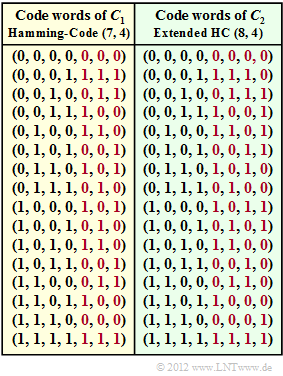Exercise 1.09: Extended Hamming Code
Two codes are to be compared, whose code tables are given on the right.
- The first four bits of each code word $\underline{x}$ are equal to the respective information word $\underline{u}$ (black font).
- Then follow $m = n- k$ parity bit (red font).
The systematic $\text{(7, 4)}$ Hamming code has already been discussed in "Exercise 1.6" and "Exercise 1.7". The parity-check matrix and generator matrix of this code are given as follows:
- $${ \boldsymbol{\rm H}}_1 = \begin{pmatrix} 1 &1 &0 &1 &1 &0 &0\\ 0 &1 &1 &1 &0 &1 &0\\ 1 &0 &1 &1 &0 &0 &1 \end{pmatrix}\hspace{0.05cm},$$
- $${ \boldsymbol{\rm G}}_1 = \begin{pmatrix} 1 &0 &0 &0 &1 &0 &1\\ 0 &1 &0 &0 &1 &1 &0\\ 0 &0 &1 &0 &0 &1 &1\\ 0 &0 &0 &1 &1 &1 &1 \end{pmatrix}\hspace{0.05cm}.$$
In the further course of the exercise this (yellow highlighted) code is called $\mathcal{C}_{1}$.
The right column in the above table specifies a block code with parameters $n = 8$ and $k = 4$, usually referred to in the literature as the "Extended Hamming Code". We refer to this code (highlighted in green) in the following $\mathcal{C}_{2}$ and denote its parity-check matrix by ${ \boldsymbol{\rm H}}_{2}$ and the corresponding generator matrix by ${ \boldsymbol{\rm G}}_{2}$.
The questions for this exercise are related to
- the "code rate",
- the "minimum distance" between two code words,
- the "parity-check matrix" and the "generator matrix" of the extended $\text{(8, 4)}$ Hamming code.
Hints:
- This exercise belongs to the chapter "General Description of Linear Block Codes".
- Note in the solution that $\mathcal{C}_{1}$ and $\mathcal{C}_{2}$ are each "systematic codes".
- The following "Exercise 1.9Z" deals with the extension of codes in somewhat more general terms.
Questions
Solution
- $\mathcal{C}_{1} \text{:} \ n = 7, k = 4\ ⇒ \ R = 4/7 \underline {= 0.571},$
- $\mathcal{C}_{2} \text{:} \ n = 8, k = 4 \ ⇒ \ R = 4/8 \underline { =0.5}.$
(2) The minimum distance of the (7, 4, 3)-Hamming code $\mathcal{C}_{1}$ is $d_{\rm min} \underline{= 3}$, which can be read from the naming alone.
- From the table on the information page, it can be seen that for the extended Hamming code $d_{\rm min} \underline{= 4}$ holds.
- $\mathcal{C}_{2}$ is therefore also called a (8, 4, 4) block code in the literature.
(3) The parity-check matrix ${ \boldsymbol{\rm H}}$ generally consists of $n$ columns and $m = n - k$ rows, where $m$ indicates the number of parity-check equations.
- For the (7, 4, 3)-Hamming code, ${ \boldsymbol{\rm H}}$ is a 3 × 7 matrix.
- For the extended Hamming code ⇒ code $\mathcal{C}_{2}$, on the other hand, $\underline{n = 8}$ (column number) and $\underline{m = 4}$ (row number) holds.
(4) From the code table on the information page you can see that only answer 3 is correct.
- The parity bit $p_{4}$ is to be determined in such a way that the modulo 2 sum over all bits of the code word results in the value $0$.
(5) It should first be noted that the specification of the parity-check matrix is never unambiguous, if only because the order of the parity-check equations is interchangeable.
- However, considering that only one of the given rows is wrong, ${ \boldsymbol{\rm H}}_{2}$ is uniquely determined:
- $${ \boldsymbol{\rm H}}_2 = \begin{pmatrix} 1 &1 &0 &1 &1 &0 &0 &0\\ 0 &1 &1 &1 &0 &1 &0 &0\\ 1 &0 &1 &1 &0 &0 &1 &0\\ 1 &1 &1 &1 &1 &1 &1 &1 \end{pmatrix} \hspace{0.05cm}.$$
- Correct are therefore the statements 1, 2 and 4. The rows of this parity-check matrix represent the four parity-check equations in this order:
- $$ x_1\oplus x_2 \oplus x_4 \oplus x_5 = 0 \hspace{0.05cm},$$
- $$x_2 \oplus x_3 \oplus x_4 \oplus x_6 = 0 \hspace{0.05cm},$$
- $$ x_1 \oplus x_3 \oplus x_4 \oplus x_7 = 0 \hspace{0.05cm},$$
- $$ x_1 \oplus x_2 \oplus x_3 \oplus x_4 \oplus x_5 \oplus x_6 \oplus x_7 \oplus x_8 = 0 \hspace{0.05cm}.$$
(6) Correct is the answer 2:
- This result is obtained by replacing the last row with the modulo 2 sum over all four rows, which is allowed.
- Proposition 1 does not represent a parity-check equation.
- Proposal 3 represents the parity-check equation $x_{3}⊕x_{5} = 0$, which also does not correspond to the facts.
According to the correct solution suggestion 2, on the other hand, the parity-check equation becomes
- $$x_1 \oplus x_2 \oplus x_3 \oplus x_4 \oplus x_5 \oplus x_6 \oplus x_7 \oplus x_8 = 0$$
replaced by the following new parity-check equation:
- $$x_1 \oplus x_2 \oplus x_3 \oplus x_8 = 0 \hspace{0.05cm}.$$
The modified parity-check matrix is now:
- $${ \boldsymbol{\rm H}}_2 = \begin{pmatrix} 1 &1 &0 &1 &1 &0 &0 &0\\ 0 &1 &1 &1 &0 &1 &0 &0\\ 1 &0 &1 &1 &0 &0 &1 &0\\ 1 &1 &1 &0 &0 &0 &0 &1 \end{pmatrix} \hspace{0.05cm}.$$
(7) After this matrix manipulation, ${ \boldsymbol{\rm H}}_{2}$ is in the form typical for systematic codes:
- $${ \boldsymbol{\rm H}}_2 =\left({ \boldsymbol{\rm P}}^{\rm T} \: ; \: { \boldsymbol{\rm I}}_m \right)\hspace{0.3cm} \Rightarrow\hspace{0.3cm} m = 4 {\rm :}\hspace{0.3cm}{ \boldsymbol{\rm H}}_2 =\left({ \boldsymbol{\rm P}}^{\rm T} \: ; \: { \boldsymbol{\rm I}}_4 \right) \hspace{0.05cm}.$$
Thus, the generator matrix is:
- $${ \boldsymbol{\rm G_{2}}} =\left({ \boldsymbol{\rm I}}_4 \: ; \: { \boldsymbol{\rm P}}\right) = \begin{pmatrix} 1 &0 &0 &0 &1 &0 &1 &1\\ 0 &1 &0 &0 &1 &1 &0 &1\\ 0 &0 &1 &0 &0 &1 &1 &1\\ 0 &0 &0 &1 &1 &1 &1 &0 \end{pmatrix} \hspace{0.05cm}.$$
So the statements 2 and 3 are correct:
- ${ \boldsymbol{\rm G}}_{2}$ starts like ${ \boldsymbol{\rm G}}_{1}$ (see specification sheet) with a diagonal matrix ${ \boldsymbol{\rm I}}_{4}$ , but unlike ${ \boldsymbol{\rm G}}_{1}$ now has 8 columns.
- In the present case $n = 8, k = 4 \ ⇒ \ m = 4$ both ${ \boldsymbol{\rm G}}_{2}$ and ${ \boldsymbol{\rm H}}_{2}$ are 4×8 matrices respectively.
